
Volume
26, No. 11 – November 2013
Volume 26, No. 11
Editor: Stephen L. Seftenberg
Website:
www.CivilWarRoundTablePalmBeach.org
President's Message
On behalf of the Executive Board I want to thank everyone who
participated in the Speaker’s Fund Drive. Your generous support of the
Round Table was thoroughly appreciated.
At the October meeting someone asked me how Civil War Round Tables
began and if there is a national headquarters. In 1939, a group of men
in Chicago decided to formalize their interest in the history of the
Civil War and formed the first "Civil War Round Table." The second
oldest is the Milwaukee Round Table. Through the years Round Tables were
started in different areas of the United States as well as other
countries. There are Round Tables in Australia, Belgium, Canada,
Denmark, France, Germany and England. Membership was often limited to
men only. Fortunately, this policy has changed.
From the beginning the purpose of a Round Table is "the study and
better understanding of the Civil War." Each one is autonomous and
operates independently with its own organization and programs. There is
absolutely no enforced conformity. Matthew Borowick has written many
articles and a handbook on the different ways Round Tables function.
There is no formal national organization or headquarters. However, in
1968, CWRT Associates was established by Jerry Russell. It served as a
clearing house to disseminate information to individual Round Tables.
Mr. Russell was chairmen until his untimely death in 2003. He was an
early advocate of Civil War preservation and worked tirelessly for this
cause. In 1975, the National Congress of CWRT was founded. These
organizations are no longer active. [Editor’s note: the web sites of
"every" CWRT in the world as of March 12, 2010 can be found on a link to
our website!]
The most amazing aspect of Round Tables is its membership. The
organizations are not just composed of historians, military experts, and
scholars, but of men and women from all walks of life who want to study
the War in greater detail. I believe that if Union and Confederate
soldiers were alive today, they would give us a nod of approval for
studying these important years in the history of our country. Each time
a Round Table member walks into a meeting I would like to think that the
Civil War veterans would say, "Our sacrifice was not in vain."
Gerridine LaRovere, President
November 13, 2013 Program
Dr. Francis J. DuCoin, a consultant at the U.S.S. Monitor Center at
the Mariners' Museum in Newport News, Virginia, will talk about "The USS
Monitor, Then and Now." Dr. DuCoin states: Everyone learned about the
battle between the Monitor and the Merrimac in fifth grade, and the
members of the Palm Beach Civil War Round Table are certainly smarter
than fifth graders, so I will not dwell on the battle. Instead I will
review the industrial and political synergy that came together so the
USS Monitor could be built; the chain of events that caused this first
battle between ironclad ships; who really won the engagement; the
discovery of the Monitor’s wreck; the recovery of and conservation of
artifacts; and the recovery and internment of two unknown sailors from
the Monitor’s turret.
October 9, 2013 Program
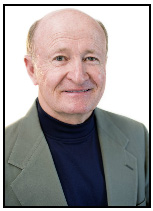 Richard
Barlow (Rich) Adams, Capt., USRA, born in San Antonio, Texas, United
States Military Academy at West Point, Class of 1967, was the first of
three brothers to graduate from West Point. After graduation, he
deployed to Vietnam as an artillery forward observer, then became a
fixed-wing aviator and transferred to the U. S. Army Corps of Engineers.
After his military service he became a consulting civil/environmental
engineer. He has served as a part-time adjunct professor in the graduate
engineering school at SMU and as an adjunct assistant professor at West
Point. Richard
Barlow (Rich) Adams, Capt., USRA, born in San Antonio, Texas, United
States Military Academy at West Point, Class of 1967, was the first of
three brothers to graduate from West Point. After graduation, he
deployed to Vietnam as an artillery forward observer, then became a
fixed-wing aviator and transferred to the U. S. Army Corps of Engineers.
After his military service he became a consulting civil/environmental
engineer. He has served as a part-time adjunct professor in the graduate
engineering school at SMU and as an adjunct assistant professor at West
Point.
His critically-acclaimed historical novels include "Eben Kruge: How
'A Christmas Carol' Came to be Written," a story about Charles Dickens
at the age of thirty and what inspired him to write the Christmas
classic, and "The Parting: A Story of West Point on the Eve of the Civil
War," a factually-based story about the West Point Class of 1861 in its
final year at the Academy, and the confrontation of best friends in the
first major battle of the Civil War. [Your editor has read the book and
recommends it highly for flowing style and meticulous craftsmanship --
you really feel what it was like to be a cadet!] Adams identified
himself as a product of 211 years of "The Long Grey Line" of West Point
graduates. He was encouraged to write The Parting by Mary
Elizabeth Sergent (1919-2005), who wrote three books chronicling the
Classes of May and June 1861 and the life of John Pelham, and challenged
him to write the story from the cadets’ points of view of the eleven
months between August 12, 1860 and July 21, 1861. He tells the story in
three flashbacks from the days before the First Battle of Bull Run
[Manassas to the South] back and forth to and from three academic
periods (summer encampment, first and second semesters).
Adams emphasized that the book was "based on facts derived from
archival research and nonfiction publications," and seasoned by his
experiences as a West Point cadet, graduate and as an adjunct assistant
professor at West Point. This research and these experiences form the
basis for the story’s portrayal of West Point in 1861, "the cadet class
system, the regimen of summer encampment, the hops at the West Point
Hotel, the meals in the mess hall, the routine of barracks life, the
academics, the extracurricular activities of the cadets and the
inexorable unraveling of the country." (The Parting, page 381).
At Adams’ request, more than a dozen attendees raised their hands to
attest that they have visited West Point. Mary Ellen Prior volunteered
that she was a graduate of Ladycliffe College, then located just outside
of Thayer Gate. Adams then disclosed that our president had dated a
cadet and had been on Flirtation Walk with him!
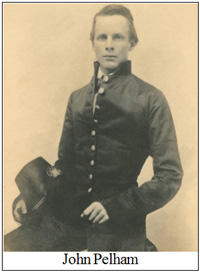 In August 1860, West Point had 278 cadets. The story focuses on John
Pelham (9/7/1838 - 3/17/1863), of Jacksonville, Alabama; his room mate,
Thomas Lafayette Rosser (10/215/1836 - 3/29/1910), born in Virginia but
raised in Texas; Edmund Kirby (5/11/1840 - 5/28/1863), of Brownsville,
New York; Henry Algernon duPont (7/30/1838-12/21/1926), of Eleutherian
Mills, Delaware; George Armstrong Custer (12/5/1839-6/25/1876), born in
New Rumley, Ohio, but raised in Monroe, Michigan; and Emory Upton
(8/27/1839-3/15/ 1881), of Batavia, New York. In August 1860, West Point had 278 cadets. The story focuses on John
Pelham (9/7/1838 - 3/17/1863), of Jacksonville, Alabama; his room mate,
Thomas Lafayette Rosser (10/215/1836 - 3/29/1910), born in Virginia but
raised in Texas; Edmund Kirby (5/11/1840 - 5/28/1863), of Brownsville,
New York; Henry Algernon duPont (7/30/1838-12/21/1926), of Eleutherian
Mills, Delaware; George Armstrong Custer (12/5/1839-6/25/1876), born in
New Rumley, Ohio, but raised in Monroe, Michigan; and Emory Upton
(8/27/1839-3/15/ 1881), of Batavia, New York.
[Note: Pelham’s 1858 photograph, taken in the Matthew Brady
studio, was well known in the South. While many copies were made, the
original was long thought lost. It was held by Pelham’s sister, Betty,
and kept by her descendants in a fire-proof safe. In 2010, Pelham’s
great-great grand-nephew consigned the picture for auction. It sold for
$41,825.]
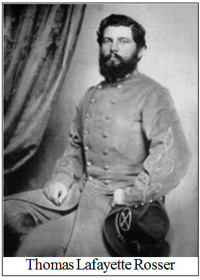 Adams introduced us to Clara Bolton, of Philadelphia, a senior at
Clermont College (both fictional) who, with five other girls and two
chaperones visited West Point in August 1860 to take part in the "hops"
(dancing) and the search for husbands, and to Benny Havens (real)
long-time tavern keeper (a thorn in the side of the Academy’s
anti-drinking rules). Benny was known for his famous "flips" (eggs, rum,
ale, sugar, spices, beaten to a frothy mixture and then heated by a
white-hot iron bar (the "flip dog"). Many generations of cadets
(including Jeff Davis, Jackson, Grant, Longstreet, Sheridan, Sherman and
Pickett) had sneaked out after taps, at the risk of being kicked out of
West Point, to experience Benny’s unique "education." Adams introduced us to Clara Bolton, of Philadelphia, a senior at
Clermont College (both fictional) who, with five other girls and two
chaperones visited West Point in August 1860 to take part in the "hops"
(dancing) and the search for husbands, and to Benny Havens (real)
long-time tavern keeper (a thorn in the side of the Academy’s
anti-drinking rules). Benny was known for his famous "flips" (eggs, rum,
ale, sugar, spices, beaten to a frothy mixture and then heated by a
white-hot iron bar (the "flip dog"). Many generations of cadets
(including Jeff Davis, Jackson, Grant, Longstreet, Sheridan, Sherman and
Pickett) had sneaked out after taps, at the risk of being kicked out of
West Point, to experience Benny’s unique "education."
Adams and a companion West Point graduate then sang several verses of
"Benny Havens, Oh," the first of over 60 verses penned by cadets by
1860:
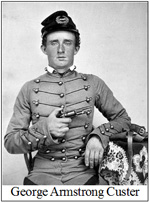 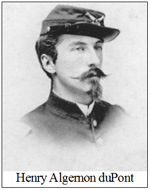 "Come fill your glasses, fellows, "Come fill your glasses, fellows,
and stand up in a row.
To singing sentimentally,
we’re going far to go.
In the Army there’s sobriety,
promotion’s very slow.
So we’ll sing our reminiscences
to Benny Havens, Oh"
The book contains the verses composed by John Pelham on the last
night at Benny Havens’ place:
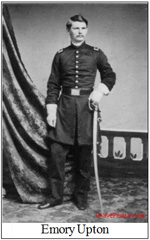 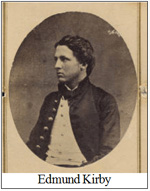 "Go we now our separate ways, "Go we now our separate ways,
fate’s not to us been just;
We know not what the future holds,
the lifeblood poured from us,
But when all is done and all is past,
we pray God heals our pain
And brings us back to Benny’s place,
to toast our bond again.
Oh! Benny Havens, Oh! --
Oh! Benny Havens, Oh!
We’ll sing our reminiscences
Of Benny Havens, Oh!"
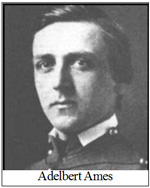 Adams pointed out that President Lincoln had offered to put Robert E.
Lee in charge of the Union Army, but Lee declined and, after Virginia
seceded, resigned from the U. S. Army and went South to glory and
tragedy. Pierre Gustave Toutant Beauregard (5/28/1818 – 2/20/1893), of
Louisiana, served as West Point Superintendent for only five days in
1861! Pelham and Rosser (against the wishes of their parents and the
advice of Lt. Fitzhugh Lee (Class of ‘56), Robert Lee’s nephew and
Tactical Officer, of Pelham’s D Company, who had advised Pelham and
Rosser to watch what he did and "Jump when I jump"), instead followed
the advice of President Davis, intending to stay until they graduated
and continue to improve their military talents. But when the Lincoln
Administration took over, the Secretary of War required all cadets to
swear an oath of allegiance to the Union and discharged all cadets who
declined to take the oath. Moreover, when word of Fitzhugh Lee’s advice
reached Republican ears in Congress, he was immediately transferred
elsewhere. Adams pointed out that President Lincoln had offered to put Robert E.
Lee in charge of the Union Army, but Lee declined and, after Virginia
seceded, resigned from the U. S. Army and went South to glory and
tragedy. Pierre Gustave Toutant Beauregard (5/28/1818 – 2/20/1893), of
Louisiana, served as West Point Superintendent for only five days in
1861! Pelham and Rosser (against the wishes of their parents and the
advice of Lt. Fitzhugh Lee (Class of ‘56), Robert Lee’s nephew and
Tactical Officer, of Pelham’s D Company, who had advised Pelham and
Rosser to watch what he did and "Jump when I jump"), instead followed
the advice of President Davis, intending to stay until they graduated
and continue to improve their military talents. But when the Lincoln
Administration took over, the Secretary of War required all cadets to
swear an oath of allegiance to the Union and discharged all cadets who
declined to take the oath. Moreover, when word of Fitzhugh Lee’s advice
reached Republican ears in Congress, he was immediately transferred
elsewhere.
Adams then stepped into the shoes of Pelham and Kirby. Lastly:
Adelbert Ames (10/31/1838 - 4/13/1933), the last Civil War veteran to
die, speaking in 1933. "War is a distant memory. So many changes – the
horse is obsolete, we fly like birds, we fought the ‘War to End All
Wars,’ Lindbergh flies from Long Island to Paris nonstop!" I remember
1st Bull Run, where I got my Congressional Medal of Honor. We started
out on a flanking maneuver that was supposed to be 7 miles but turned
out to be 14. By the time we got there, we were worn out. Through my
binoculars, I saw John Pelham on his horse."
Adams said he had circled cadets’ pictures in his 1967 West Point
yearbook from states that had been in the United States in 1860 and
imagined them parting. "It breaks my heart to see the tragedy of
parting. Truly, the war was brother fighting brother. He then brought to
our attention, Reconciliation Plaza, financed by the West Point Class of
1961. It is the largest monument at West Point and the names of all
cadets on both sides of the Civil War are inscribed on black granite.
Over 900 West Pointers fought in the war. By war’s end almost 450 were
generals! Of the 60 major battles in the Civil War, 55 were commanded by
West Pointers on both sides; the other 5 had at least one side commanded
by a former West Point cadet.
 Adams finished by putting a chart on the screen breaking down cadets
who served and who died: Adams finished by putting a chart on the screen breaking down cadets
who served and who died:
The Round Table gave Russ Adams a round of applause for his
presentation (especially his singing!).
A Fight in the Fields:. The Impact of the Civil War on
Midwestern Agriculture
By Robert C. Welch, The Courier, Civil War Round Table of Central
Florida [edited]
As war tore the nation apart, farmers in the Midwest, or the
Northwest as it was known then, faced major adjustments to their ways of
life. While fighting never reached these areas, the largest issue facing
farmers during the war was the lack of manpower due to military
enlistments. While not every male eligible to serve enlisted, many
states saw a sizeable portion of that population go to war. For example,
49% of Iowa's male population of military age served in the Union Army,
the highest percentage of any Northern state. Of all the men that served
in the Union Army, 48% were farmers. With this large body of manpower
unavailable to work, the wages laborers demanded rose. Families
struggled to continue the work that fathers, husbands, and sons left
them. Boys took greater responsibility on the farm, learning by trial
and error or by advice found in letters from the front. Many wives and
daughters took to the fields to make sure the farm survived.
 Responding to labor shortages, farmers quickened the pace of
adaptation to new technologies chiefly machines designed for harvesting
crops. Rather than taking days to harvest crops by hand, farmers
invested in devices that yielded faster harvests of larger fields.
During this time, manufacturers changed the way they marketed their
goods. Images within the ads showed women operating the machines,
demonstrating their ease of use for women in charge of field work while
men were off to war. Other ads showed crippled veterans, most noticeably
missing one arm, operating mowers or reapers, as in the ad at the right! Responding to labor shortages, farmers quickened the pace of
adaptation to new technologies chiefly machines designed for harvesting
crops. Rather than taking days to harvest crops by hand, farmers
invested in devices that yielded faster harvests of larger fields.
During this time, manufacturers changed the way they marketed their
goods. Images within the ads showed women operating the machines,
demonstrating their ease of use for women in charge of field work while
men were off to war. Other ads showed crippled veterans, most noticeably
missing one arm, operating mowers or reapers, as in the ad at the right!
The Civil War also helped push Midwestern farmers closer to a more
commercial model of agriculture. As with any war, troops need to be fed,
clothed, and their supplies moved from place to place and farmers
supplied the army with horses, mules, pork, beef and wool for uniforms.
The price of wool skyrocketed with the demand for new uniforms. The army
and navy needed to eat, and farmers rushed to fill contracts for pork
and beef with meat packers. Canning increased shelf life. Investing in
extra animals in the short run provided farmers with added cash income
through the commercial marketing of animals for the war effort.
The war acted as a catalyst for change in agriculture, opening the
way for major changes in farming during the second half of the
nineteenth century.
Last changed: 10/28/13
Home
About News
Newsletters
Calendar
Memories
Links Join
|

